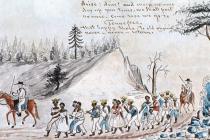You know about the Underground Railroad. But what about the Reverse Underground Railroad?
By Richard Bell
Richard Bell is an associate professor of history at the University of Maryland and the author of “Stolen: Five Free Boys Kidnapped Into Slavery and Their Astonishing Odyssey Home.”
Though the heroic stories of African American freedom-seekers have been the subject of television shows, museums, walking tours and a whole catalog of books, it took until this month for Harriet Tubman, the most famous conductor on the Underground Railroad, to get top billing in a movie. But the release of “Harriet” doesn’t complete the story of the journeys that slaves made between the North and South.
We’re still missing out on vital cultural depictions of the Reverse Underground Railroad, the criminal network of human traffickers and slave traders who stole away tens of thousands of free African Americans from the Northern states to sell them into slavery in the Deep South. Without that half of the story, we can’t possibly understand what life was like in the North for ostensibly free black people — and how tenuous their liberation could be.
The free black people these traffickers kidnapped could fetch up to $15,000 in today’s economy in Louisiana, Mississippi and Alabama. The settlers swarming into that region required a nearly bottomless supply of forced labor to cut sugar cane and pick cotton. But Congress had outlawed the transatlantic slave trade in 1808, and the legal interstate trafficking of enslaved people within the United States had not been able to keep up with ever-rising demand. The more that new planters were willing to pay, the more tempting and profitable it became for anyone sufficiently cold-blooded to try to abduct free people from Northern cities, smuggle them into the legal supply chain, and sell them in this vast new slave market.
These incentives left the North’s large and dynamic black communities dangerously exposed. Free black men, women and children went about their business, keenly aware that the threat of abduction and coerced migration into slavery lay around every corner.
Although it’s true that the most famous rider on this Reverse Underground Railroad — Solomon Northup — recently received the Hollywood treatment in Steve McQueen’s 2013 adaptation of his memoir, “Twelve Years a Slave,” Northup’s experiences were far from typical.
Most kidnappings were committed not by smartly dressed con artists, but by poorer people. These human traffickers generally avoided approaching highly literate, middle-age men such as Northup, preferring instead to lure away poor street children who could not read or write, boys and girls they hoped would be easier to dupe and control. Their prisoners rarely ended up in showrooms or on the auction block; rather, they were generally sold off in ones and twos on dusty roads and driveways deep in the Southern interior.
This is almost exactly what happened to 10-year-old Cornelius Sinclair, one of five free black boys kidnapped from central Philadelphia over a single day in August 1825. His captors hustled him onto a ship just outside the city. They warehoused him for a time in a pair of safe houses on the Delmarva Peninsula. Then they marched him and four other boys to the Deep South — a journey of 2 million steps — to be sold as slaves.
There are reasons, of course, why stories such as Sinclair’s have been buried for so long. Most prisoner-passengers on the Reverse Underground Railroad did not return to freedom to tell their tales. Their captors kept deliberately low profiles; the identities of all but a handful still remain a secret. Only rarely do their names and crimes appear in surviving police files or trial transcripts, their low profiles the result of the years they spent in the shadows, protected by bribes, avarice and indifference. These outlaws did not bequeath their papers to Southern colleges or historical societies, and left no business records or bundles of private letters for historians to examine. They did not write memoirs or pose for paintings or photographs. Their homes and warehouses no longer stand.
Yet these professional kidnappers left their mark everywhere and spirited into slavery roughly as many African Americans as Tubman and her comrades and collaborators ever assisted in escaping from it. They, too, looked to exploit, as the operators of the Underground Railroad did, major differences in the legal status of slavery in the North and the South. They, too, were loosely organized and opportunistic. And they, too, ran on secrecy and relied on small circles of trusted participants, forged documents, false identities and disguises. And though the direction of travel was different, the routes taken by northbound freedom seekers helped by Tubman and by southbound victims of kidnapping such as Cornelius Sinclair were largely the same.
Thanks in large part, now, to “Harriet,” Tubman’s achievements are at the forefront of the United States’ imagination. But Cornelius Sinclair deserves his moment, too.





